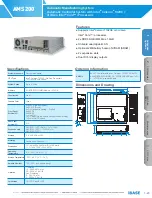
VC 5000
10
©Copyright Eaton Corp., 2019. All rights reserved.
2.4.1
Foundations must be set so distance ‘X”, shown on
Figure
9
, is established. If the clutch is mounted on
a shaft having plain bearings, make sure the shaft
is centered within the bearings when establishing
the “X” dimension. Refer to Table 2 for appropriate
“X” dimensions.
Note
: It is presumed that one of the shafts has
been properly located and anchored.
Figure 9
2.4.2
Fabricate a rigid bracket for supporting a dial
indicator and attach to the spider. See
Figure 9
.
2.4.3
Thoroughly clean the flange O.D. and the face of
the drum hub where alignment readings are to be
taken.
2.4.4
Rotate the spider and take parallel alignment
readings off the drum hub flange O.D. If both shafts
can be rotated together, the alignment readings are
less influenced by any surface irregularities.
⚠
CAUTION
When recording parallel alignment readings,
“sag” of the indicator/indicator bracket must be
accounted for.
2.4.5
Angular alignment readings can be made by
accurately measuring the gap between the spider
and drum hub faces with an inside micrometer. If a
dial indicator is used, make sure to monitor and
correct for any axial movement of the shaft. To
reduce the influence any surface irregularities may
have on the angular alignment readings, index the
spider 90 degrees after taking the initial set of
readings. Take an additional set of readings and
index the spider another 90 degrees. Continue in
this manner until four sets of readings have been
taken. For misalignment correction, use the
average of the four readings at each position. In
other words, average the four top readings, the four
bottom readings, and each of the four side
readings.
2.4.6
Shim and shift the base of the movable shaft to
correct the misalignment. After tightening the base,
recheck the alignment and correct if necessary.
Make sure to check for a “soft foot” condition.
Dowel or chock into position after satisfactory
alignment has been achieved.
Note
: On many applications, thermal growth of the
driving or driven machinery may result in
unacceptable shaft alignment in a running
condition. It is always a good practice to make a
“hot alignment” check and the shim if necessary.
2.5
Installation of Element and Drum
(Narrow, Dual Narrow and Single Wide)
2.5.1
Note the orientation of the drum flange with respect
to the air connection(s) on the element and slide
the drum into the element.
2.5.2
Separate the shafts as far as the bearing
clearances will allow and hoist the element/drum
into position.
2.5.3
Attach the drum to the drum hub with the
appropriate fasteners. See Table 1. Make sure the
bore in the drum flange fully engages the pilot on
the drum hub.
⚠
WARNING
Use only the proper grade and number of
fasteners. Using commercial grade fasteners
(Grade 2) in place of Grade 8 fasteners (where
called for) may result in failure of the fasteners
under load, causing personal injury or
equipment damage.
2.5.4
Install the air connection gaskets onto the air tubes.
The metal backup washer is to be positioned
towards the elbow (away from the spider). See
Figure 10
.
Note
: Some older elements use a flanged air
connection tube and a thin gasket. See Table 3 for
correct part numbers.












































